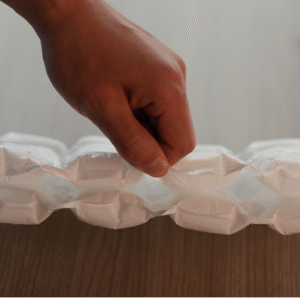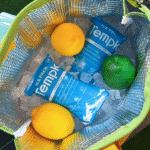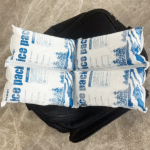حزمة هلام مقابل الجليد الجاف: أي حل السلسلة الباردة هو الأفضل لشحنتك?
عند شحن المنتجات الحساسة لدرجة الحرارة, اختيار حل التبريد -حزم هلام أو الثلج الجاف- يمكن أن تؤثر بشكل كبير على سلامة شحنتك, يكلف, والأداء. هذه المقالة تحطم الاختلافات الرئيسية بين هذين الخيارين, مساعدتك في تحديد أي واحد مثالي لاحتياجات سلسلة البرد الخاصة بك 2025.
-
ال التحكم في درجة الحرارة قدرات حزم الهلام والثلج الجاف
-
اعتبارات التكلفة لكلا الخيارين, بما في ذلك قابلية إعادة الاستخدام والتأثير البيئي
-
ال مخاوف السلامة مرتبط بكل حل
-
أفضل سيناريوهات لاستخدام حزم الهلام والثلج الجاف في شحن سلسلة البرد
ماذا حزم هلام وثلج جاف?
حزم هلام: نظرة عامة
حزم هلام مرنة, حلول تبريد قابلة لإعادة الاستخدام التي تحتوي على هلام غير سامة داخل غلاف بلاستيكي. إنهم يعملون من خلال الحفاظ على درجة حرارة معتدلة, عادة بين 32° F و 50 درجة فهرنهايت (0درجة مئوية إلى 10 درجة مئوية), جعلها مناسبة ل منتجات مبردة مثل الطعام, مستحضرات التجميل, والأدوية التي تتطلب التبريد ولكن لا تتجمد.
الجليد الجاف: نظرة عامة
الجليد الجاف, مصنوعة من مجمدة ثاني أكسيد الكربون (CO2), صامت في -109.3° f (-78.5درجة مئوية), مما يجعلها مثالية ل المنتجات المجمدة مثل اللحوم, المأكولات البحرية, والعينات البيولوجية. إنه خيار الانتقال عندما تتطلب المنتجات درجات حرارة منخفضة للغاية لفترات طويلة.
كيف تقارن حزم الهلام والثلج الجاف?
نطاق درجة الحرارة: الذي يبقي منتجاتك أكثر برودة?
-
الجليد الجاف: مثالي لدرجات حرارة التجمد, الحفاظ على العناصر في دون الصفر مستويات.
-
حزم هلام: الأفضل للتبريد المعتدل, عادة الحفاظ على درجات الحرارة بين 32° F و 50 درجة فهرنهايت (0درجة مئوية إلى 10 درجة مئوية).
مدة: كم من الوقت يستمرون?
-
الجليد الجاف: يسامي مع مرور الوقت, عمومًا يوفر مدة تبريد أقصر ما لم يكن معبأة بكفاءة.
-
حزم هلام: توفير أطول, تبريد أبطأ ولكن لا يمكن الوصول إلى درجات الحرارة القصوى التي يوفرها الجليد الجاف.
السلامة والتعامل: وهو أكثر أمانًا لفريقك?
-
حزم هلام: آمن للمس والتعامل مع, مع عدم وجود معدات خاصة.
-
الجليد الجاف: يتطلب القفازات والتهوية المناسبة بسبب البرد الشديد والحاجة تراكم ثاني أكسيد الكربون, التي يمكن أن تكون خطرة في المساحات المغلقة.
مقارنة التكلفة: وهو أكثر ملاءمة للميزانية?
| محلول التبريد | التكلفة المقدمة | إعادة الاستخدام | تكلفة الشحن | كفاءة التكلفة الإجمالية |
|---|---|---|---|---|
| حزم هلام | أدنى | قابلة لإعادة الاستخدام | أدنى | فعال من حيث التكلفة للشحنات قصيرة الأجل |
| الجليد الجاف | أعلى | استخدام واحد | أعلى | مكلف للشحنات طويلة الأجل |
-
حزم هلام أكثر حل فعال من حيث التكلفة بالنسبة للشركات التي تبحث عن تبريد قصير الأجل دون الحاجة إلى درجات حرارة منخفضة للغاية.
-
الجليد الجاف عادة أكثر تكلفة مقدما وهو أ منتج الاستخدام لمرة واحدة, مما يجعلها أكثر ملاءمة للشحنات التي تتطلب درجات حرارة منخفضة فائقة لفترات طويلة.
مخاوف السلامة: وهو أكثر أمانًا للتعامل معه?
-
حزم هلام: أكثر أمانًا للتعامل, مع عدم وجود انبعاثات سامة أو مخاطر باردة شديدة. يمكن لمسها وإعادة استخدامها بأمان.
-
الجليد الجاف: يتطلب التعامل الخاص. قضمة الصقيع يمكن أن يحدث عند الاتصال المباشر, والثلج الجاف يمكن أن يحل محل الأكسجين في المساحات المحصورة, يحتمل أن يسبب الاختناق.
متى يجب أن تستخدم حزم الجل?
حزم هلام هي مثالية ل:
-
شحنات قصيرة الأجل حيث يكون التحكم في درجة الحرارة أمرًا بالغ الأهمية
-
المنتجات التي تحتاج التبريد المعتدل (على سبيل المثال, طعام غير قابل للتلف, مستحضرات التجميل, الأدوية)
متى يكون الجليد الجاف الخيار الأفضل?
الجليد الجاف ضروري متى:
-
شحن أغذية مجمدة مثل اللحوم, المأكولات البحرية, أو الآيس كريم
-
التعامل عينات بيولوجية أو الأدوية التي تتطلب درجات حرارة منخفضة للغاية
-
نقل البضائع أكثر مسافات أطول أو فترات الشحن الممتدة
الاتجاهات الناشئة في شحن السلسلة الباردة: ماذا تتوقع في 2025
مع تطور صناعة السلسلة الباردة, عديد الابتكارات تعمل على تحسين كفاءة حلول التبريد واستدامته:
-
بدائل مستدامة: تكتسب حزم الهلام الصديقة للبيئة والتعبئة القابلة للتحلل الشعبية شعبية.
-
تقنيات المراقبة المتقدمة: تضمن أنظمة مراقبة درجة الحرارة في الوقت الفعلي المدعوم من إنترنت الأشياء تتبعًا أفضل وامتثالًا.
-
مواد تغيير المرحلة (PCMS): تقدم هذه المواد التحكم في درجة الحرارة المتسق لفترات أطول, أن تصبح بديلاً قابلاً للتطبيق لكل من حزم الهلام والثلج الجاف.
الأسئلة المتداولة
س 1: أي حل يدوم أطول - حزم الجليد أو الجليد الجاف?
-
يميل الجليد الجاف إلى الاستمرار لفترة أطول, خاصة بالنسبة لدرجات حرارة فائقة الانخفاض, في حين أن حزم الهلام أكثر فاعلية ل التبريد المعتدل على مدى فترة أطول.
Q2: هي حزم هلام آمنة لشحنات الطعام?
-
نعم, حزم الهلام آمنة لشحن الطعام, خصوصاً غير قابل للتلف العناصر التي تحتاج إلى البقاء باردة, ولكن ليس مجمدة.
س 3: هل يمكنني استخدام الثلج الجاف للعناصر المبردة?
-
لا ينصح بالثلج الجاف للعناصر المبردة كما يوفر بارد شديد. حزم الهلام أكثر ملاءمة للحفاظ على العناصر باردة دون تجميدها.
الخلاصة والتوصيات
الاختيار بين حزم هلام و الثلج الجاف يعتمد على احتياجات درجة حرارة شحنتك. حزم هلام هي مثالية للتبريد المعتدل وأكثر من ذلك فعالة من حيث التكلفة للشحنات قصيرة الأجل. لكن, الثلج الجاف ضروري للشحنات التي تتطلب درجات حرارة منخفضة للغاية وفترات أطول. من خلال تقييم نوع المنتج وظروف الشحن, يمكنك اتخاذ قرار مستنير.
نصيحة عملية: إذا كان عملك جديدًا في لوجستيات سلسلة البرد, ابدأ بحزم هلام للمنتجات غير المجمدة وتجربة الجليد الجاف لأولئك الذين يتطلبون البرد الشديد.
حول Tempk
في Tempk, نحن متخصصون في توفير حلول سلسلة باردة مبتكرة لجميع احتياجات الشحن الخاصة بك. منتجاتنا, بما في ذلك عبوات هلام وثلج جاف, تم تصميمها للحفاظ على سلامة منتجاتك أثناء العبور. نحن نعطي الأولوية الاستدامة و كفاءة التكلفة في جميع حلولنا.
للحصول على مشورة الخبراء, تواصل معنا اليوم!
























